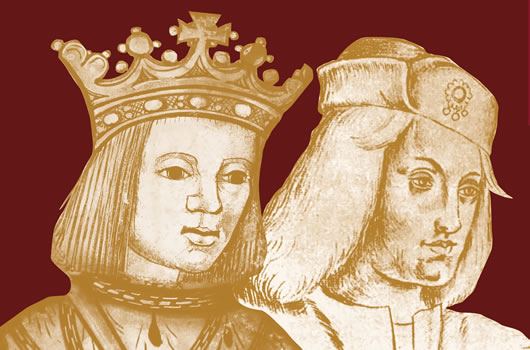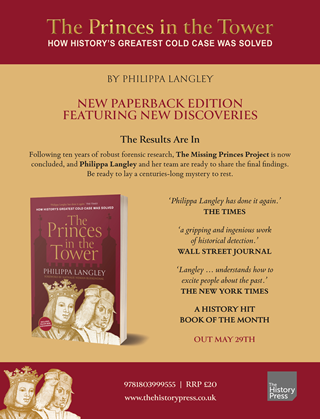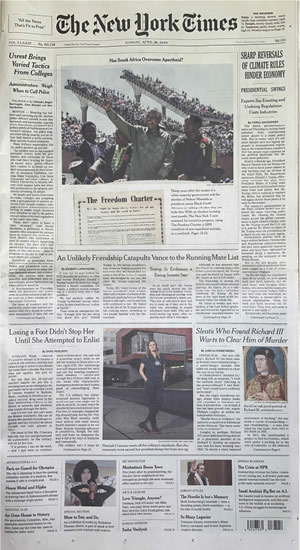The Princes in the Tower: How History's Greatest Cold Case Was Solved (The History Press, 29 May 2025)
Soft Cover Edition - With More New Discoveries
Following ten years of robust forensic research, The Missing Princes Project is now concluded, and Philippa Langley and her international team are ready to share the final findings. Be ready to lay a centuries-long mystery to rest. This newly revised and updated landmark publication reveals an astonishing untold story of the continued lives of the Princes in the Tower, uncovering remarkable new archival discoveries of proof of life. It is the first time that police cold case investigation analysis has been applied to a centuries-old historical mystery, leaving no stone unturned, and the results are extraordinary, rewriting history. Chapters 18 and 19 are fully updated and a new Chapter 21 publishes further archival discoveries. Revealing the totality of evidence uncovered, the title of the best-selling book is also updated - the case is solved. For more on this history-defining publication, see here. See interview below.
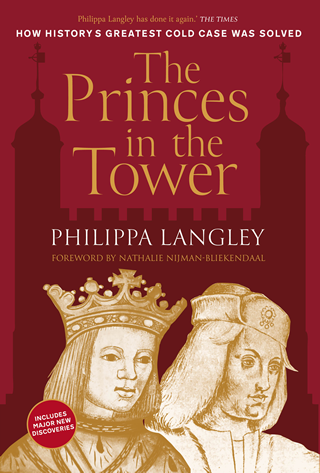
The Princes in the Tower: How History's Greatest Cold Case Was Solved (The History Press, published 29 May 2025).
The Princes: Case Solved (2025) - The New Evidence Interview
You can now read an exclusive interview with Philippa Langley and key researcher for The Missing Princes Project, Nathalie Nijman-Bliekendaal. Here Philippa and Nathalie reveal the ten-year report of the project and its remarkable new archival discoveries from 2024. As Alec Marsh, editor of the Ricardian Bulletin magazine, writes:
Princes in the Tower
'Case Closed'
After nearly ten years of work, the final report of The Missing Princes Project is now here - providing more evidence than ever that the traditional story of the Princes in the Tower was a tissue of Tudor lies. Philippa Langley and Nathalie Nijman-Bliekendaal here tell Alec Marsh about the latest findings.'
First published in the June 2025 edition of the Ricardian Bulletin magazine, pp.44-49, you can now read the full, exclusive interview here.
'Princes Mystery Finally Laid to Rest' (The Times, 23 May 2025)
With Leader Page
The release of the new updated edition of The Princes in the Tower, newly subtitled: How History's Greatest Cold Case Was Solved received a stunning review from The Times newspaper today as it revealed the most recent proof of life discoveries made by The Missing Princes Project for both Princes. You can read Jack Blackburn, History Correspondent, review here.
The Times also included an 'era-defining' statement piece on its Leader page. The Leader article added that 'the last Plantagenet king may have been subjected to one of the greatest miscarriages of justice in history'. You can read the Leader Page article here.
Philippa Langley, originator and lead member of The Missing Princes Project international research initiative, called the Leader article 'a significant step forward in the history of research into the life and times of Richard III'. Paying tribute to her team of over three hundred researchers from around the world, Langley added that there was so much more to come with some of the project's key researchers considering publication of their own books as they unravel key lines of investigation.
The team also joined Amanda Geary, Chair of the Richard III Society, in thanking The Times for its balanced approach (see The Times letters page: Monday 26 May 2025).
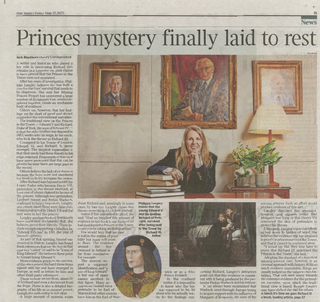
The Times (23 May 2025), 'Princes mystery finally laid to rest'.
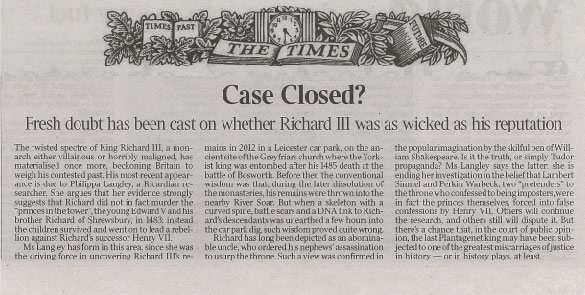
The Times, Leader Page (23 May 2025), 'Fresh doubt has been cast on whether Richard III was as wicked as his reputation'.
The Princes in the Tower: The New Evidence
Watch Philippa Langley's seven-year search for the truth across seven countries with a team of over three hundred researchers. First broadcast on Saturday 18 November 2023 with Historian and British Barrister Rob Rinder MBE (Channel 4, Brinkworth Productions). The Princes in the Tower is a gripping and ingenious work of historical detection. Ms. Langley and her team have cast new light into a murky period, and with a methodological brilliance that eludes most academic historians." The Wall Street Journal. "Bombshell new evidence" Daily Mail. Watch the full feature-length documentary here.
"And that's how you solve a 500 year-old mystery"
This was the sign-off from the award-winning Nieuwsuur [News-Hour] programme on 29 January 2024 for the segment on the Princes in the Tower from Nos, the Dutch National broadcaster. Interviewed for the programme are Philippa Langley, Nathalie Nijman-Bliekendaal and Professor Janina Ramirez. News Reporter is Fleur Launspach.
Where can I find the full results and totality of evidences for The Missing Princes Project?
A complete and detailed account is now available in: The Princes in the Tower: Solving History’s Greatest Cold Case (The History Press, 19 November 2023). For more on this landmark work see here and here. It is also available online here. For the North American edition (Pegasus Books, 19 November 2023), see here, and also available online here. The fully updated 2025 edition: The Princes in the Tower: How History's Greatest Cold Case Was Solved is available online here. See above for more information on the new 2025 edition and publication of the cold case investigation's final ten-year report.
Where can I find the feature-length TV documentary special?
The Princes in the Tower: The New Evidence premiered on Channel 4 on Saturday 18 November 2023 at 8.00pm and is now available on All 4 (C4 VoD service). For more information see here and here. Documentary also aired in North America on PBS on 22 November as part of the Secrets of the Dead series. More information is available here. For European broadcasts, please see your local channels. Documentary broadcast in Australia on Sunday 19th November on SBS.
It is hoped that a DVD of the UK feature-length TV documentary will be made available.
The Princes in the Tower: The New Evidence (Brinkworth Productions) Dir. Janice Sutherland.
What did the project’s investigative specialists advise?
Firstly, ‘follow the money and the law’ and examine all day-to-day administrative records, this is where truth will be found. These are written by clerks, lawyers and accountants and as a result have no reason to lie. They were not written for public consumption and is where the Police begin all their investigations. Secondly, look at everything; you can’t prejudge or cut off any lines of investigation. And thirdly to not use hindsight, begin with a clean sheet and live at all times in the present – their present, minute by minute, hour by hour, day by day. Create timelines and person of interest files. Cross check and cross-reference everything.
What are the project’s four headline discoveries?
These are, firstly, the product of intelligence gathering and forensic investigation of contemporary records undertaken over a four year period to 2019. And secondly, archival evidence uncovered when the project was extended into the reign of Henry VII (d.1509).
Discovery 1: Forensic investigation of all records dating to the reign of Richard III revealed no evidence of the death of Edward V or Richard, Duke of York. Both individuals are referenced as alive in all existing day-to-day accounting and legal records.
Discovery 2: Forensic investigation of all materials relating to the Battle of Bosworth (22 August 1485) revealed that the story of the murder of the Princes originated in England with the arrival of Henry Tudor and his French invasion force (dated to 14 August 1485). Following the victory of Tudor’s forces (and death of King Richard in battle), and the interrogation of Yorkist/Ricardian prisoners, Henry delayed his march to London in order to conduct searches for the Princes in the north of England.
Discovery 3: Edward V: Proof of Life (aged 17). In May 2020, Albert Jan de Rooij of the Dutch Research Group discovered in the archive of Lille in France a receipt belonging to King Maximilian I dated 16 December 1487 and referencing Margaret of Burgundy (Edward’s aunt). The receipt is signed by three leading members of Maximilian’s court and records the king’s collection of, and payment for, 400 pikes (weapons for elite troops). The weapons had been collected by Maximilian in June of that year. The receipt states that the weapons were: ‘to serve her nephew – son of King Edward, late her brother (may God save his soul), [who was] expelled from his dominion.’ Four of the receipts details confirm the weapons were for Edward V. He was the nephew of Margaret of Burgundy, the son of King Edward (IV), the right age to lead an army and fight in battle (16), and had been ‘expelled from his dominion’ (to the Channel Islands). The Lille receipt also suggests that Edward V was alive, or thought to be alive, in December 1487 (age 17). This was after the Battle of Stoke on 16 June 1487.
To view the Lille Receipt, please see: 'The Discoveries: Images' section below.
Discovery 4: Richard, Duke of York: Proof of Life (aged 20), 1493. In November 2020, Nathalie Nijman-Bliekendaal of the Dutch Research Group rediscovered a four page, semi-legal manuscript in the Gelderland archive, in Arnhem in the Netherlands. It is a witness statement written in the first person and records Richard, Duke of York’s story from the point at which he left sanctuary in Westminster in London as a 9 year-old boy in 1483, to his arrival at the court of his aunt, Margaret of York, in Burgundy in circa 1493-4. The witness statement provides extensive detail.
To view the Gelderland Manuscript, please see: 'The Discoveries: Images' section below.
Has any other evidence come to light?
Further proof of life discoveries support the survival of Richard, Duke of York.
In February 2019, Nathalie Nijman-Bliekendaal of the Dutch Research Group rediscovered a receipt and pledge of payment by ‘Richard of England’ to Duke Albert of Saxony dated 4 October 1493 in the Dresden archive in Germany. The receipt/pledge payment is for 30,000 florins (a significant sum). It is signed by ‘Richard of England’ with his royal monogram and seal. The receipt is also signed by two of his supporters: Sir Robert Clifford and William Barley, Esquire. To our current knowledge, this is the only surviving royal seal for Richard IV of England.
In December 2020, Zoë Maula of the Dutch Research Group discovered a letter from King Maximilian to Henry VII of England in the Austrian archives, dated 27 November-12 December 1493. In the letter Maximilian states that Henry will know that Richard, Duke of York is the true son of King Edward because he can be recognised by ‘several signs’ including three birthmarks or body marks that ‘cannot be counterfeited’. Richard of York, writes Maximilian, would ‘show several signs by which those who knew him in his youth would recognize him, and especially three natural marks which he has on his body and which cannot be counterfeited, that is: his mouth, one of his eyes and a mark he has on his thigh.’ As a young man, Richard, Duke of York, was recognised by Sir Robert Clifford by his physical marks. Clifford had known York as a child. His aunt Margaret of Burgundy also recognised York as her nephew by the conversations they'd had in 1480 (when York was 7), what he knew about Edward IV and by his physical marks, which not one in ten thousand (a million) could have. The Irish lords had also met the young Prince in 1479 when he was 6 years old and recognised him on his return to Ireland in 1491 as a young man.
A search by Jean Roefstra and Nathalie Nijman-Bliekendaal of the Domain Accounts in archives across the Netherlands revealed the journey undertaken by Richard, Duke of York to the north of Holland in 1494-5. These extensive searches further revealed that he was known as Richard, Duke of York, the son of Edward IV, or the ‘White Rose’. No other name was attributed to him.
A letter patent in the National Library of Ireland, dated 13 August 1486, is now attributed to Edward V (aged 15). Attached to the grant is his royal seal with the royal arms of England and closed crown of a king.
How did you authenticate and interrogate these key discoveries – i.e., why are they proofs of life?
Each discovery was interrogated in three parts, providing three reasons for a firm attribution of authenticity:
First, these are archival discoveries so had been previously authenticated by the relevant archives.
Second, they were re-checked by the archive’s specialists when alerted to their potential importance.
Third, they were checked once again by the documentary filmmakers (including a number of historians) who then engaged independent specialists to confirm their authenticity. These included Professor Henrike Lähnemann and Professor Janina Ramirez, and for the Gelderland manuscript three specialists at Het Gelders Archief: Dr Fred van Kan, archivist and general director, Marjolein Jacobs-Driessen, MA, historian and archivist, Leanne Eras, MA, conservator, and leading international specialist Dr Andrew Dunning, Curator of Medieval Manuscripts at the Bodleian Library in Oxford.
The transcription and translation of the Gelderland manuscript was checked for the TV documentary programme by Middle Dutch writing expert, Associate Professor Bart Lambert at the Brussels Centre for Urban Studies in Belgium. Professor Lambert made a few minor corrections which are now published in The Princes in the Tower: How History's Greatest Cold Case Was Solved (2025).
What was the influence and catalyst for The Missing Princes Project?
The project was influenced by the Looking for Richard Project (2005-2015) and the importance of evidenced-based research. A great deal of that research countered the belief of historians (based on 17th and 18th century stories) that Richard III’s body had been exhumed (his stone coffin becoming a horse trough) and, in another story, his remains thrown into the River Soar. Much of that project was about undertaking evidence-based research to find out what actually happened, to determine where the king was buried.
The catalyst for this new project was a full-page article in the Daily Mail published on 24 March 2015 during reburial week. The headline read: ‘It’s mad to make this child killer a national hero’. It reiterated a lot of the traditional narrative which might, of course, have been true but it didn’t cite any evidence. As I headed home from Leicester after the reburial, it was clear I needed to undertake another evidence-based project.
What is the value of employing police investigative methodology?
It teaches us the importance of forensic techniques when studying history, to cross-reference and cross-check everything; to follow the money and the law to uncover the truth - the day-to-day administrative records not meant for public consumption; to search; to eliminate hindsight and conscious bias and to always work in the present (your subject’s present); to build extensive timelines and person of interest files, and to refrain from closing off, disregarding or ignoring any potential lines of investigation due to personal opinion or pre-judgement or because famous writers have done so in the past. Park all of that; start with a clean sheet, be your own boss and above all - question, question, question. To continually question is the biggest take away.
Can this methodology change how we study and research history?
Yes, undoubtedly. If cold case methodology had been applied to this mystery through the centuries, there would have been no need for The Missing Princes Project.
With the totality of evidences presented and the mystery solved, a reassessment of two dynasties – York and Tudor – through the reigns of Richard III and Henry VII, is an exciting next step. These new discoveries have changed what we know about both monarchs. We look forward to what the young historians of today will discover tomorrow.
Were there any key moments?
The publication of a new edition of Domenico Mancini in which the conscious bias of the original 1936 translation had been removed. For more on this important work see here. For anyone studying this period of history, this new translation is a must-read.
In the Channel 4 TV Documentary special, it has been reported that Rob Rinder was given pre-filming knowledge of the European destinations visited in the programme as well as pre-filming sight of the archival discoveries themselves. Is this correct?
Rob was not provided with prior knowledge of the European filming locations or archival discoveries. Everything you see on screen happened in real time. The journalist who filed this report did not contact Philippa or the film team beforehand. If we might please ask all journalists to first check the facts with us, it would be greatly appreciated.
In the TV documentary, Philippa Langley states that there are no bodies which can be identified as those of the Princes in the Tower, and this is why she undertook a police cold case missing person investigation to unlock the mystery. Why is she deliberately ignoring the burials of the two young Princes in the urn in Westminster Abbey?
A TV documentary is only allocated a certain amount of time. For those who wish to know more about the remains in the urn, Philippa has covered this particular issue in forensic detail in Chapter 9 of her book: The Princes in the Tower: How History's Greatest Cold Case Was Solved. Put simply there is no historical, archaeological or scientific evidence that these are the remains of the Princes in the Tower. As they were uncovered at a depth of ten feet down in the foundation level of the Tower building, the remains are likely to be of Saxon, Roman or Norman origin and could be a foundation burial, common at these times. For more see pp. 153-157 and Appendix 10, pp. 387-395. Skeletal remains uncovered at this depth and close to this location have been carbon-dated to the Iron Age.
Philippa has therefore called for the ‘bones in the urn’ to be reinvestigated.
For more on the bones in the urn in Westminster Abbey see here.
A number of commentators have reported that the archival ‘proof of life’ discoveries made by The Missing Princes Project prove nothing as they simply represent the impostors ‘Lambert Simnel’ and ‘Perkin Warbeck’ with false royal names and titles. Is this correct?
This supposition rests on the belief that the royal houses of York and Europe were happy to allow the public denigration of their blood royal, ancestral lines and royal majesty. In allowing common boys to be crowned and anointed in place of Plantagenet heirs, not only questioned their own right to the throne but also set an incredibly dangerous precedent: that any common person can be a king. The supposition also rests on the belief that the Houses of York and Europe were willing to denigrate and disparage the most sacred and holy ceremony of the church and to ignore the Plantagenet heirs to the English throne. At the time of ‘Lambert Simnel’ this was Richard III’s heir, John de la Pole, Earl of Lincoln; and at the time of ‘Perkin Warbeck’ this was Lincoln’s brother, Edmund de la Pole, 3rd Duke of Suffolk. A police missing person investigation cannot rely on assumptions, it must always search for evidence. The only Plantagenet heirs with a greater claim to the throne than Lincoln and Suffolk were the sons of Edward IV, who in January 1486 had been re-legitimated by the actions of Henry VII in the English Parliament.
The above is reinforced by the vast sums of money invested by European rulers to finance five invasion forces in support of both Yorkist claimants to the throne of England.
What next for The Missing Princes Project?
Phase Two:
Although the completion of Phase One means that so many pieces of the jigsaw puzzle surrounding this centuries-old mystery are now in place, our work nevertheless continues to search archives around the world, to gather intelligence and, through evidence-based research, tell the remarkable stories of Edward V and Richard, Duke of York. In the future we may be able to discover the final resting places of both Princes, thereby honouring them and their fight for the throne of England against the first Tudor monarch.
Finally, the debate about the fate of the Princes in the Tower is so embedded in peoples’ psyche thanks to Shakespeare’s famous play and Thomas More’s literary narrative that some may not believe or agree with the evidence laid out in the book and documentary – what would you say to those people?
I absolutely understand this view, change is difficult. Before Richard III was discovered, everyone thought his remains had been exhumed and his (supposed) sarcophagus coffin became a horse trough or his remains had been thrown into the nearby river because of later rumour, hearsay and gossip. We no longer believe these stories.
Evidence-based research enables people to hold an informed opinion, and if you have an opinion that contradicts the evidence, you have to ask yourself why.
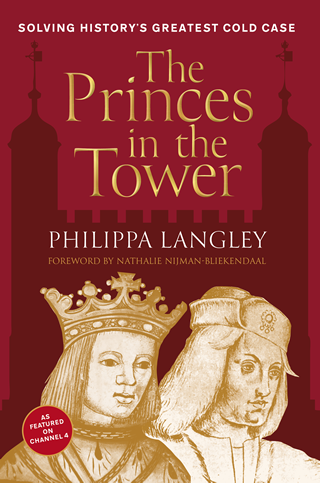
The History Press, UK, 19 November 2023.
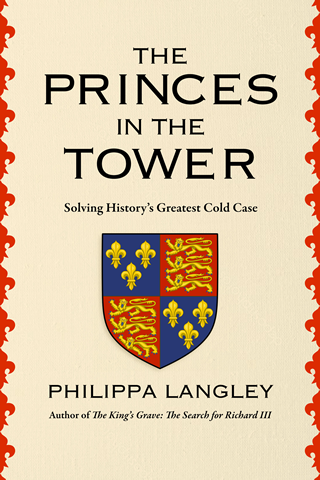
Pegasus Books, USA, 19 November 2023.
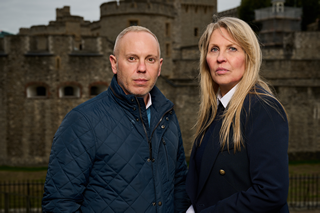
Philippa Langley and Rob Rinder at the Tower of London. Channel 4, image: Robert Parfitt.
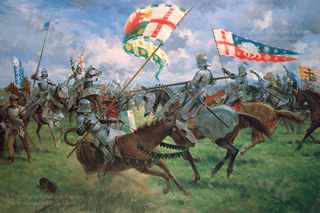
The Battle of Bosworth – King Richard’s Charge (22 August 1485) by Graham Turner studio88.co.uk.
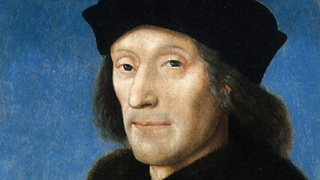
Henry VII (1457-1509).
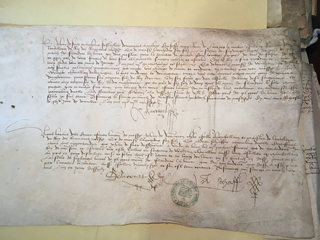
Lille Receipt - Edward V: Proof of Life, 16 December 1487. Archives Départementales du Nord, Lille: ADN B 3521/124564.
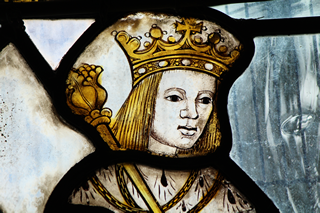
Edward V (16) from coronation: Sunday 27 May 1487, Dublin. Image: John Dike, St Matthew’s Church, Coldridge, Devon.
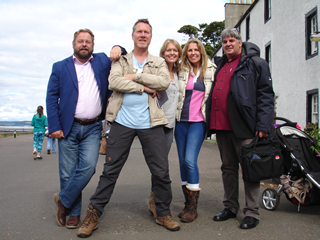
Dutch Research Group, Albert Jan de Rooij, 2nd from left.
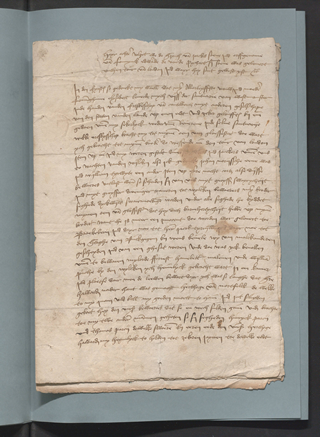
Gelderland Witness Statement (semi-legal, 4 pages) – Richard, Duke of York: Proof of Life, 1493. Gelders Archief, Arnhem, Netherlands, 0510, Nr. 1549 Diverse charters/diverse aanwinsten.
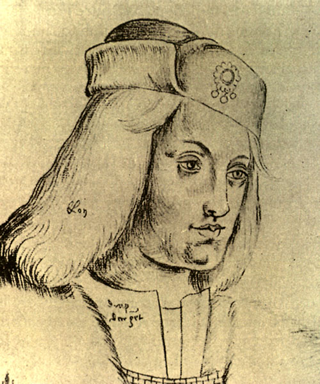
Richard, Duke of York (20) c.1494, pencil sketch (c.1560) from painting (uncredited). Library of Arras.
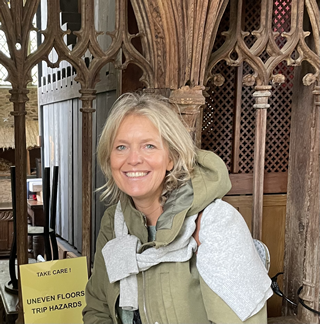
Nathalie Nijman-Bliekendaal, Dutch Research Group.

Zoë Maula, Dutch Research Group.
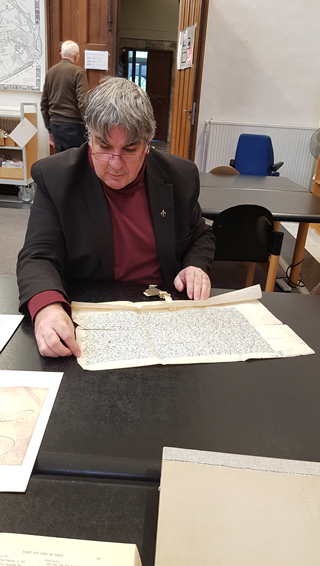
Jean Roefstra, Dutch Research Group. Image: Nathalie Nijman-Bliekendaal
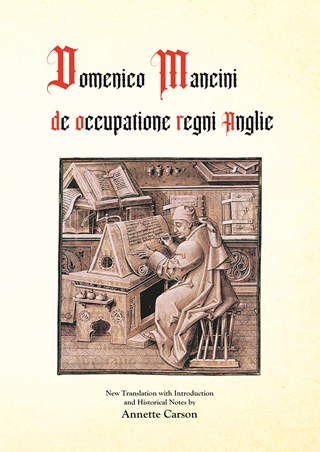
Domenico Mancini: de occupatione regni Anglie New Translation with Introduction and Historical Notes (2021), Annette Carson (ed).

Rob Rinder and Philippa Langley filming in Edinburgh.
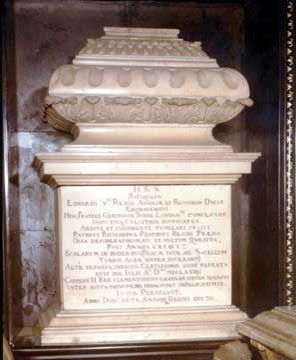
Urn, Westminster Abbey. Photo: Matt Lewis.
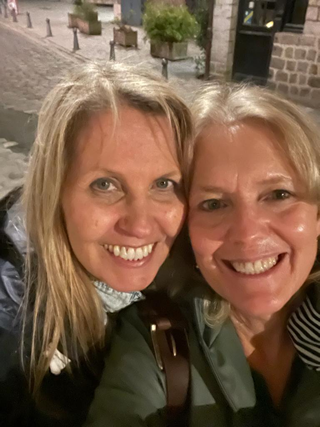
Philippa Langley and Nathalie Nijman-Bliekendaal filming in Lille.
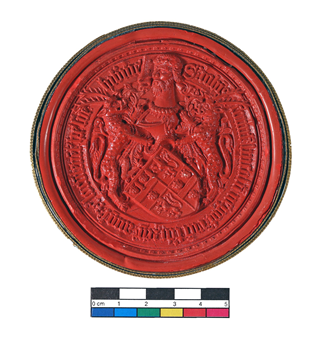
‘Royal Matrix Seal of John de la Pole, Earl of Lincoln, heir to Richard III.’ Image: British Museum, No. 1838,1232.16.
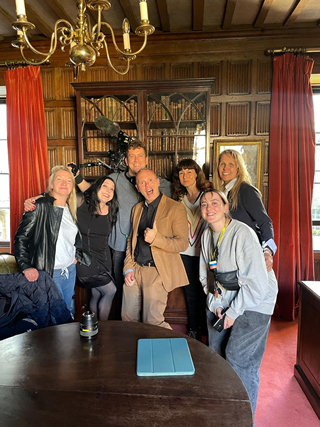
Professor Janina Ramirez with Rob, Philippa & crew filming at Oxford University.
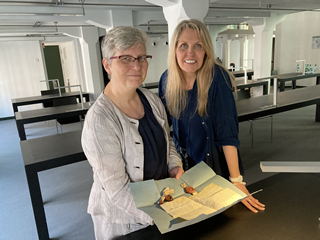
Professor Henrike Lähnemann with Philippa filming in Dresden State Archive, Germany.
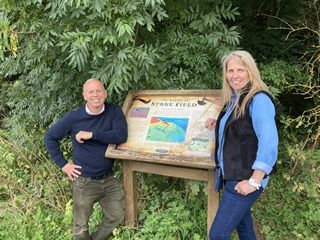
Rob and Philippa filming at the Battle of Stoke.

Rob, Philippa and Matt Lewis filming at the Battle of Stoke. Image courtesy of Rob Rinder.

‘Truth is the daughter of time, not of authority.’
Sir Francis Bacon (1561-1626)
The Princes in the Tower: 'History is Being Rewritten' Breaking News – (16 November 2023)
The Richard III Society is the first to break the news regarding the extraordinary archival discoveries made by The Missing Princes Project research initiative and surrounding the mysterious disappearance of the Princes in the Tower in 1483. The five-year report of the project's international investigation is about to be revealed. 'From now on, history must take account of this new breakthrough evidence. No longer can anyone confidently claim the princes were killed by Richard III'. You can read the Press Release here and here. The Richard III Society is one of the oldest and largest historical societies in the world. The Society's Patron is HRH: Prince Richard, Duke of Gloucester KG, GCVO.
Princes in the Tower: The New Evidence Wins Best Historical Documentary Award – (22 November 2024)
With congratulations to Brinkworth Productions and Director Janice Sutherland on wining the award for Best Historical Documentary for their acclaimed feature-length documentary special: The Princes in the Tower: The New Evidence (November 2023). The documentary won in the Historical category at the recent Association of International Broadcasters (AIB) Awards. The AIBs recognise the highest standards of journalism and factual productions across TV, radio and digital platforms. In 2024 they received the highest number of entries in the history of the competition with over 400 hours of work submitted. Congratulations to all the team on receiving this outstanding award and for achieving the highest standards of journalism and reporting.
About the Landmark Documentary
What happened to the Princes in the Tower? This revelatory landmark documentary will open up one of English history’s greatest mysteries in a continent-crossing journey with Philippa Langley and Rob Rinder. Powered by remarkable new discoveries and years of research, Philippa – the writer who located the final resting place of Richard III – has teamed up with criminal barrister Rob Rinder to deliver an immersive investigation that will call into question everything we think we know about this notorious incident in our royal past.
Did Richard III orchestrate the brutal murder of the two young princes, his nephews Edward and Richard, as Shakespeare claimed? Or does this famous cold case contain a more complex truth?
A decade on from making worldwide headlines with the spectacular discovery, exhumation and reburial of Richard III, Philippa is back – this time armed with a stack of fresh leads provided by her team of researchers from across the globe and the help of Rob Rinder. Together they embark on a road trip that will take them across seas, into archives and deep into the heart of medieval Europe. Can they find England’s missing royals?
The title premiered on Saturday 18 November at 8pm and was extremely well received by viewers and critics alike, clocking up overnights of 1.3m and a 10.3% audience share which was up 121% on ABC1’s. The film trended on social media and made press headlines around the world.

The Princes in the Tower: The New Evidence - winner: Best Historical Documentary, AIB Awards 2024.

Filming in Dresden, Germany.

Filming at Stoke Field.

Malcolm Brinkworth (Executive Producer, The Princes in the Tower: The New Evidence) collects the Best Historical Documentary Award at the AIBs on 22 November 2024.
Hold the Front Page! – (June 2024)
The Missing Princes Project has made the front cover of the July/August 2024 edition of National Geographic History magazine (out now in June). It is the most incredible honour for this original (and international) research initiative and its remarkable archival discoveries to have achieved this recognition. Thank you. The magazine includes a full-page editorial from Amy Briggs, Editor-in-Chief, for her last issue after more than eight years at the helm. Thank you Amy. An excerpt from The Princes in the Tower: Solving History's Greatest Cold Case (Pegasus Books, USA) features across twelve pages.
Hold the Front Page! – (Sunday 28 April 2024)
On Sunday 28 April 2024, The Missing Princes Project made the front page of The New York Times. It is the most incredible honour. With heartfelt thanks to this leading broadsheet for its interest and to reporter Amelia Nierenberg. The project's investigations continue apace.
The Nuremberg Discoveries
In 2024, researcher Nathalie Nijman-Bliekendaal made a series of remarkable discoveries in the archives at Nuremberg in Germany concerning Richard of England. Nathalie’s ongoing research uncovered no less than three authentic charters and four original letters, written respectively by Richard of England, King James IV of Scotland and Henry VII. The charters and letters signed by Richard of England include his royal seal and sign manual. These surviving royal artefacts are significant and exquisite and tell us about the movements, affinity, bodyguard and dealings of Edward IV’s youngest son during the latter years of his eight-year bid for the throne of England (1491–99).
Nathalie is working with independent historical researcher Erik Verroken. Nathalie and Philippa are grateful for Erik’s commitment to The Missing Princes Project and his invaluable contributions and help.
You can now read about these new remarkable discoveries in The Princes in the Tower: How History's Greatest Cold Case Was Solved (2025).
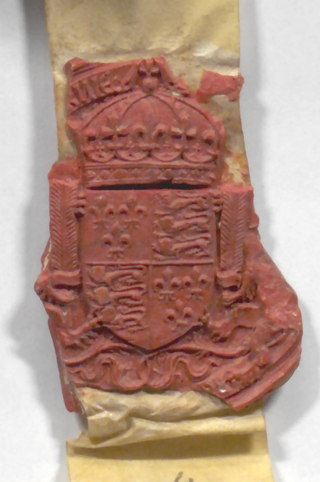
Richard of England’s royal seal with Ostrich Feathers of the Prince of Wales, 15 November 1496: Nuremberg State Archive, Secret Archive of the Principality of Ansbach (Foreign Documents): Document 250.
The Discoveries: Images
For ease of access, The Missing Princes Project international research initiative now publishes low-resolution images of some of its most remarkable archival discoveries. To obtain copies for research purposes, please contact the relevant archive (see below).
For further information and translations of these important discoveries, please see: The Princes in the Tower: How History's Greatest Cold Case Was Solved. For more information on this best-selling new book, please see here
For the Lille Receipt, 16 December 1487, please see here. With thanks to: Archives Départementales du Nord, Lille (Departmental Archives of the North, Lille): ADN B 3521/124564.
For the Gelderland Manuscript, c.1493-4, please see here. With thanks to: Gelders Archief, 0510 ‘Diverse Charters en Aanwinsten [Various Charters & Acquisitions]’, nr 1549.
For the Nuremberg Charters and Letters, please see below: With thanks to: Germanisches National Museum, Historic Archive, Archive of the Wolkenstein-Rodenegg Family and the Nuremberg State Archive, Secret Archive of the Principality of Ansbach (Foreign Documents): Documents: 248–51 and 257.
For Richard of England's Charter to Veit von Wolkenstein of 4 April 1494, please see here.
For Richard of England's Charter to Michael von Wolkenstein Charter of 5 April 1494, please see here.
For Richard of England's Letter to Ludwig Wolfgang Tetzel of 15 November 1496, please see here.
For Richard of England's Charter to Ludwig Wolfgang Tetzel Charter of 20 November 1496, please see here.
For James IV's Letter to Ludwig Wolfgang Tetzel of 31 July 1496, please see here.
For James IV's Letter to Ludwig Wolfgang Tetzel of 20 October 1496, please see here.
For Henry VII's Letter to Ludwig Wolfgang Tetzel of 16 November 1501, please see here.
Research Update: August 2025
Prince Edward (Edward V) with the Irish Lords and Clergy: Feast of the Ascension, Windsor Castle, Thursday 20 May 1479
New research carried out by the team for the Mary Shelley line of investigation has discovered that an important group of Irish lords and clergy were present with Prince Edward (later Edward V) at the Feast of the Ascension at Windsor Castle on Thursday 20 May 1479. Also present at this significant court observation was Edward IV. Having seen (and met) Prince Edward in May 1479, team leader Denise Testa concludes: ‘In a period where few facts are verifiable, there is one thing we do know. This same group of Irish nobles and clergy who were so often at odds with one another, would now unite under one cause. Those who had spent months at Edward IV’s court in 1479, would to a man, recognize the young claimant as Edward V.’
Edward was proclaimed king in Dublin on Thursday 24 May, the Feast of the Ascension. He would be crowned king three days later on Sunday 27 May 1487, the first Sunday after the Feast of the Ascension. His mother, Elizabeth Woodville, had been crowned on this same holy day, twenty-two years earlier.
The Irish lords present at Windsor on 20 May 1479 were: Gerald FitzGerald, 8th Earl of Kildare; Brother James Keating, Prior of the Hospital of St. John of Jerusalem in Ireland; John Walton, English canon, became Archbishop of Dublin in 1472; William Stewart, Prior of All Saints by Dublin; Alexander Plunkette (esquire, appointed Chancellor of Ireland in 1492); Sir Roland Fitz-Eustace; Walter FitzSimons (Archbishop of Dublin in 1487, reputedly crowned Edward V) and William Wellysley de Dengyn (knight and owner of Dangan Castle).
You can now read Denise M Testa’s Research Report, ‘Relations Between Edward IV’s Sons and the Irish Nobility of 1479’, 10 August 2025, here.
Denise thanks Evelyn Apolinária for her transcription of Prince Edward’s Chester letters. The Missing Princes Project would like to thank Denise and her team for bringing this important new discovery to light.
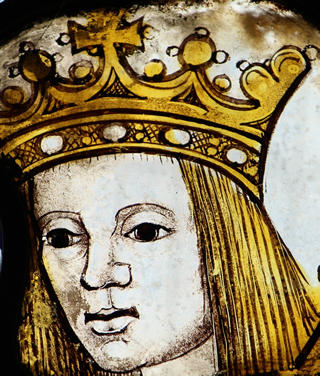
Edward V from Dublin coronation, first Sunday after the Feast of the Ascension (27 May 1487). Stained glass window, Coldridge Church, Devon.
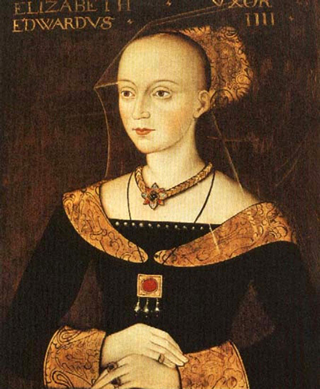
Edward V's mother, Elizabeth Woodville. Elizabeth crowned on same holy day (first Sunday after Ascension), 22 years earlier.
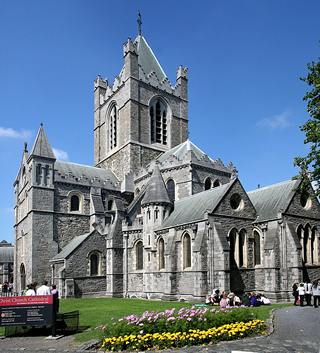
Christ Church Cathedral, Dublin. Irish Lords and Clergy crown Edward V on Sunday 27 May 1487.

